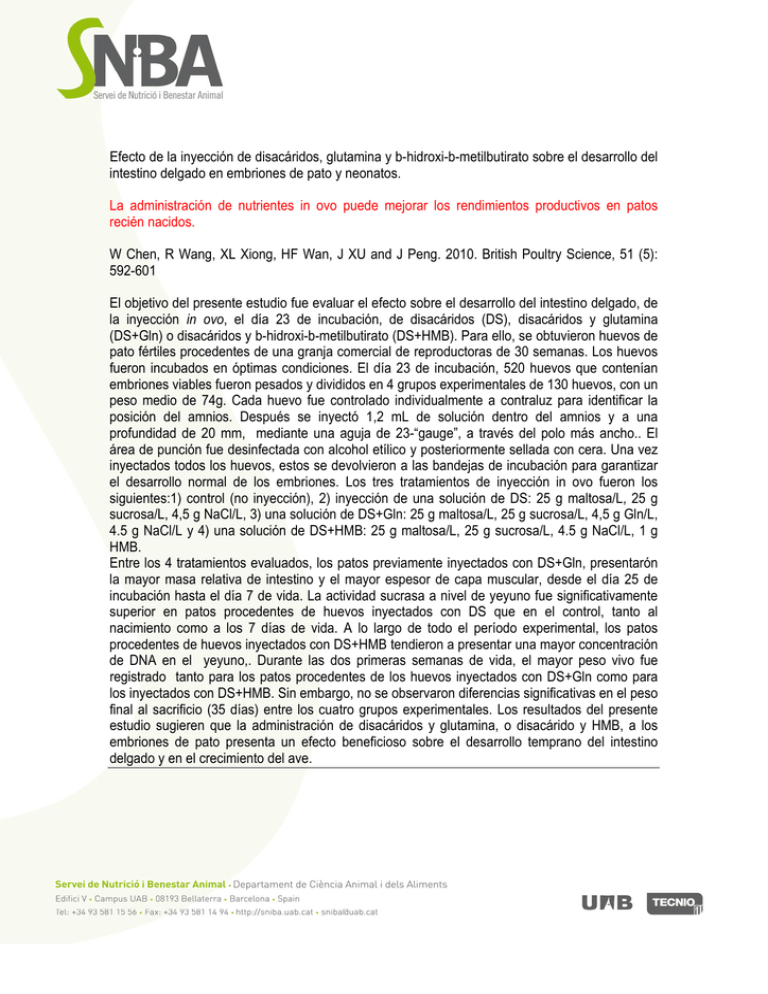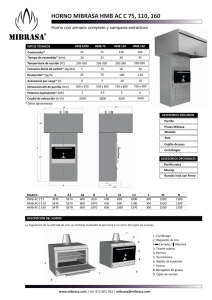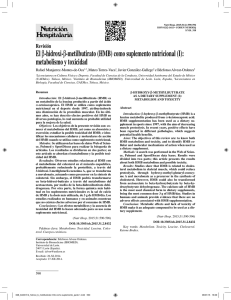Efecto de la inyección de disacáridos, glutamina y b-hidroxi
Anuncio

Efecto de la inyección de disacáridos, glutamina y b-hidroxi-b-metilbutirato sobre el desarrollo del intestino delgado en embriones de pato y neonatos. La administración de nutrientes in ovo puede mejorar los rendimientos productivos en patos recién nacidos. W Chen, R Wang, XL Xiong, HF Wan, J XU and J Peng. 2010. British Poultry Science, 51 (5): 592-601 El objetivo del presente estudio fue evaluar el efecto sobre el desarrollo del intestino delgado, de la inyección in ovo, el día 23 de incubación, de disacáridos (DS), disacáridos y glutamina (DS+Gln) o disacáridos y b-hidroxi-b-metilbutirato (DS+HMB). Para ello, se obtuvieron huevos de pato fértiles procedentes de una granja comercial de reproductoras de 30 semanas. Los huevos fueron incubados en óptimas condiciones. El día 23 de incubación, 520 huevos que contenían embriones viables fueron pesados y divididos en 4 grupos experimentales de 130 huevos, con un peso medio de 74g. Cada huevo fue controlado individualmente a contraluz para identificar la posición del amnios. Después se inyectó 1,2 mL de solución dentro del amnios y a una profundidad de 20 mm, mediante una aguja de 23-“gauge”, a través del polo más ancho.. El área de punción fue desinfectada con alcohol etílico y posteriormente sellada con cera. Una vez inyectados todos los huevos, estos se devolvieron a las bandejas de incubación para garantizar el desarrollo normal de los embriones. Los tres tratamientos de inyección in ovo fueron los siguientes:1) control (no inyección), 2) inyección de una solución de DS: 25 g maltosa/L, 25 g sucrosa/L, 4,5 g NaCl/L, 3) una solución de DS+Gln: 25 g maltosa/L, 25 g sucrosa/L, 4,5 g Gln/L, 4.5 g NaCl/L y 4) una solución de DS+HMB: 25 g maltosa/L, 25 g sucrosa/L, 4.5 g NaCl/L, 1 g HMB. Entre los 4 tratamientos evaluados, los patos previamente inyectados con DS+Gln, presentarón la mayor masa relativa de intestino y el mayor espesor de capa muscular, desde el día 25 de incubación hasta el día 7 de vida. La actividad sucrasa a nivel de yeyuno fue significativamente superior en patos procedentes de huevos inyectados con DS que en el control, tanto al nacimiento como a los 7 días de vida. A lo largo de todo el período experimental, los patos procedentes de huevos inyectados con DS+HMB tendieron a presentar una mayor concentración de DNA en el yeyuno,. Durante las dos primeras semanas de vida, el mayor peso vivo fue registrado tanto para los patos procedentes de los huevos inyectados con DS+Gln como para los inyectados con DS+HMB. Sin embargo, no se observaron diferencias significativas en el peso final al sacrificio (35 días) entre los cuatro grupos experimentales. Los resultados del presente estudio sugieren que la administración de disacáridos y glutamina, o disacárido y HMB, a los embriones de pato presenta un efecto beneficioso sobre el desarrollo temprano del intestino delgado y en el crecimiento del ave. Influence of in ovo injection of disaccharides, glutamine and b-hydroxy-b-methylbutyrate on the development of small intestine in duck embryos and neonates In ovo nutrient administration may improve growth performance in newborn ducks W Chen, R Wang, XL Xiong, HF Wan, J XU and J Peng. 2010. British Poultry Science, 51 (5): 592-601 The objective of the present study was to examine the effect of in ovo injection of disaccharides (DS), disaccharides and glutamine (DS+Gln) or disaccharides and b-hydroxy- b-methylbutyrate (DS+HMB) at d 23 of incubation on the development of the small intestine. Fertile duck eggs were obtained from a commercial maternal duck flock at 30 weeks in. The eggs were incubated under optimal conditions. At 23 d of embryonic incubation (23E), 520 eggs containing viable embryos were weighed and randomly divided into 4 treatment groups of 130 eggs, each with an average egg weight of 74 g. each egg was candled to identify the location of the amnion. A hole was then punched in the blunt top of the egg using a needle, and 12ml of injection solution was injected into the amnion using a 23-gauge needle to a depth of about 20 mm. The injection hole area was disinfected with an ethyl alcohol swab and sealed with wax. After all the eggs were injected, the eggs were returned to hatching baskets to ensure the normal development of embryos. The three in ovo injected treatments were as follows. 1) DS injection solution: 25 g maltose/L, 25 g sucrose/L, 4.5 g NaCl/L, 2) DS+Gln injection solution: 25 g maltose/L, 25 g sucrose/lL 4.5 g Gln/L, 4.5 g NaCl/L and 3) DS+HMB injection solution: 25 g maltose/L, 25 g sucrose/L, 4.5 g NaCl/L, 1 g HMB. In DS+Gln-injected ducks, the greatest relative small intestine mass and muscularis layer thickness among 4 treatments was observed from d 25 of incubation to 7 d of age. Jejunal sucrase activity in DS-injected ducks was significantly greater than in controls at hatch and on d 7. In DS+HMB-treated ducks, a tendency toward slightly higher jejunal DNA concentration was observed throughout the experiment. Greater body weight was found in DS+Gln and DS+HMB treated ducks in the first two weeks. However, there was no significant difference in the market weight (35 d) of ducks among the 4 treatments. The results of present study suggest that administering disaccharides and Gln, or disaccharides and HMB, to the duck embryos exerted a beneficial effect on the early development of small intestine and on growth performance.



